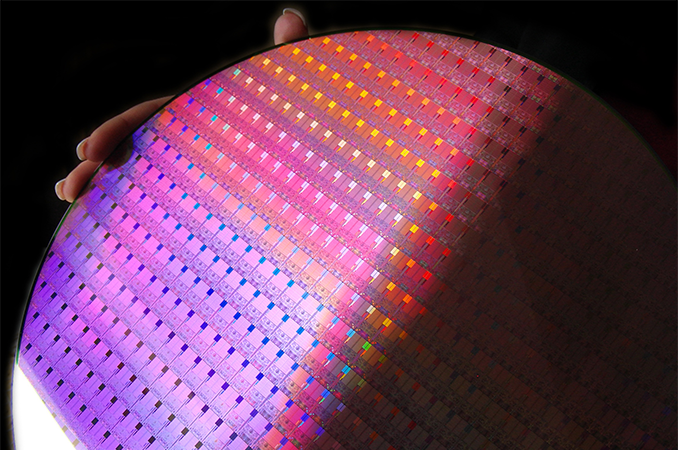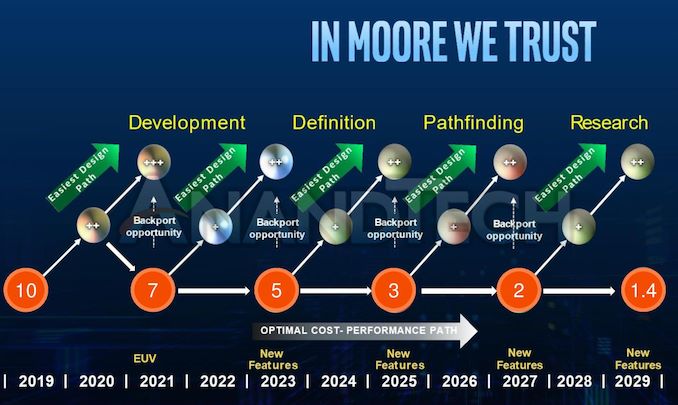Intel’s Manufacturing Roadmap from 2019 to 2029: Back Porting, 7nm, 5nm, 3nm, 2nm, and 1.4 nm
by Dr. Ian Cutress on December 11, 2019 3:00 PM EST
Update: After some emailing back and forth, we can confirm that the slide that Intel's partner ASML presented at the IEDM conference is actually an altered version of what Intel presented for the September 2019 source. ASML added animations to the slide such that the bottom row of dates correspond to specific nodes, however at the time we didn't spot these animations (neither did it seem did the rest of the press). It should be noted that the correlation that ASML made to exact node names isn't so much a stretch of the imagination to piece together, however it has been requested that we also add the original Intel slide to provide context to what Intel is saying compared to what was presented by ASML. Some of the wording in the article has changed to reflect this. Our analysis is still relevant.
One of the interesting disclosures here at the IEEE International Electron Devices Meeting (IEDM) has been around new and upcoming process node technologies. Almost every session so far this week has covered 7nm, 5nm, and 3nm processes (as the industry calls them). What we didn’t expect to see disclosed was an extended roadmap of Intel’s upcoming manufacturing processes. It should be noted that the slide presented at the conference by Intel's partner, ASML, was modified slightly from its original source.
They say a slide is worth 1000 words. Here’s 1000 words on Intel's future.

Intel's slide, as presented in September
This is Intel's original slide, not detailing which nodes in which years. However, it should be easy enough to figure out that each one of the elements in the bottom row is the next process node along, otherwise the +/++ wouldn't make sense.
ASML applied these assumptions to the slide it presented at the IEDM keynote, but the company did not disclose that they had modified the slide.

Intel's slide with ASML's animations overlayed, as shown in the slide deck distributed by ASML
So let’s go through some key areas.
1.4nm in 2029
Intel expects to be on 2 year cadence with its manufacturing process node technology, starting with 10nm in 2019 and moving to 7nm EUV in 2021, then a fundamental new node in each of 2023, 2025, 2027, 2029. This final node is what ASML has dubbed '1.4nm'. This is the first mention on 1.4nm in the context of Intel on any Intel-related slide. For context, if that 1.4nm is indicative of any actual feature, would be the equivalent of 12 silicon atoms across.
It is perhaps worth noting that some of the talks at this year’s IEDM features dimensions on the order of 0.3nm with what are called ‘2D self-assembly’ materials, so something this low isn’t unheard of, but it is unheard of in silicon. Obviously there are many issues going that small that Intel (and its partners) will have to overcome.
+, ++, and Back Porting
In between each process node, as Intel has stated before, there will be iterative + and ++ versions of each in order to extract performance from each process node. The only exception to this is 10nm, which is already on 10+, so we will see 10++ and 10+++ in 2020 and 2021 respectively. Intel believes they can do this on a yearly cadence, but also have overlapping teams to ensure that one full process node can overlap with another.
The interesting element to these slides is the mention of back porting. This is the ability for a chip to be designed with one process node in mind, but perhaps due to delays, can be remade on an older ‘++’ version of a process node in the same timeframe. Despite Intel stating that they are disaggregating chip design from process node technology, at some point there has to be a commitment to a process node in order to start the layouts in silicon. At that point the process node procedure is kind of locked, especially when it goes to mask creation.
In the slide, it shows that Intel is going to allow a workflow such that any first gen 7nm design could be back ported to 10+++, any first gen 5nm design could be back ported to 7++, and so on. One can argue that this roadmap might not be so strict with the dates – we have seen Intel’s 10nm take a long time to bake, so expecting the company to move with a yearly cadence on + updates alongside a two-year cadence with main process technology nodes would appear to be a very optimistic and aggressive cadence strategy.
Note that this isn’t the first mention of back porting hardware designs when it comes to Intel. With the current delays to Intel’s 10nm process technology, it has been widely rumoured that some of Intel’s future CPU microarchitecture designs, originally designed with 10nm (or 10+, 10++) in mind might actually find a home on a 14nm process due to the success of that process node.
Development and Research
Normally with process node developments, there will be different teams working on each process node. This slide states that Intel is currently in development of its 10+++ optimizations as well as the 7nm family. The idea is that the ‘+’ updates are capturing the low hanging fruit from a design standpoint every generation, and the number represents a full node benefit. Interestingly we see Intel’s 7nm being based on 10++, whereas in the future Intel sees 5nm come from the base 7nm design, and 3nm coming from 5nm. There is no doubt that some of the optimizations that enter each +/++ update will filter into future designs as and when they are needed.
In this slide, we have Intel’s 2023 node currently in the definition stage. At this IEDM conference there’s a lot of talk about 5nm in this timeframe, so some of those improvements (such as manufacturing, materials, consistency, etc.) will ultimately end up in Intel’s process depending on which design houses they partner with (historically Applied Materials). It is worth noting that 5nm is listed as a 2023 node, which is around the time that ASML will start selling its ‘High NA’ EUV machines to help with better path definition during the manufacturing process. I’m not sure if High NA will intercept at 5nm or 3nm, assuming this Intel roadmap has its dates correct and Intel is able to stick to it, but it is something to consider
Beyond 2023, Intel is currently in the ‘path-finding’ and 'research' mode. As always when looking this far out, Intel is considering new materials, new transistor designs, and such. At this IEDM conference we’re seeing a lot of talk of gate-all-around transistors, either as nano-sheets or nano-wires, so no doubt we’re going to see some of that as FinFET runs out of steam. TSMC is still using FinFETs for its 5nm process (Intel’s 7nm equivalent), so I wouldn’t be surprised if we see something like nano-sheets then nano-wires (or even hybrid designs) come into Intel’s manufacturing stack.
It’s worth also pointing out, based on the title of this slide, that Intel still believes in Moore’s Law. Just don’t ask how much it’ll cost.










138 Comments
View All Comments
Korguz - Friday, December 13, 2019 - link
rooting for intel for the sake of competition ?? considering they stagnated the cpu market for 3 or 4 years... no thanks... better to root for amd... at least they are doing something to move the cpu market forward.. more so then intel hasnn68 - Friday, December 13, 2019 - link
More announcements? Gee, I'm gagging. XDCeToBe - Friday, December 13, 2019 - link
IntelThe presentation in the slide of the future should at least better be called: In more we trust. That is of course meant for the interested parties, who have lost trust. For Intel to get it back, the slide will be contra-productive.
Building on an old prophecy and no longer valid law(s) is not the way to do it. Better is to express a new mission and goals and then a strategy to obtain these. The setup should be built on frontier-science, technical possibilities, ecological and economical aspects as well as political considerations.
It is doubtful that anyone these days can give a reasonably reliable outlook for the node in 2029. It’s is furthermore questionable if the node is the most trust-giving characteristic of the forthcoming products.
ASML
The slide of ASML gives even more ashtonishment. Is it the mother of all slides or a child?
If a derivate, are there no other clients of ASML with other slides?
Commercially not a good move.
BACK TO THE FUTURE
If the slide is a kind of attempt to influence the future. Expect some new ones in this theatre soon.
croc - Monday, December 16, 2019 - link
What I REALLY want to see is a 5 year roadmap of Intel's chipsets. CPUs are nice and all, but the real meat is what they run on. Hopefully the good Dr. can make this a priority, right after he looks at my knee...:-)Revv233 - Sunday, December 29, 2019 - link
Personally I wouldn't mind seeing ice lake running @ 5ghz on 14nm with it's 18% IPC gain. Maybe that's not good for the future of cpu short term but would be the fastest chip around in a long time.At some point all chip manufacturers will have to take a long look at IPC as they will no longer be able to brute Force advancements out of process nodes.
Feels a lot like the netburst days all over again. The mobile cores are running lower clocks at lower speeds less power consumption with most of the performance still there.
Anyone remember when the adapters to convert laptop chips to desktop motherboards were around? Led benches for over a year before Intel launched the core models.
travelingpin - Friday, February 21, 2020 - link
Tempat wisata <a href="https://travelingpin.com/objek-wisata/devoyage-bog... bogor</a>dan <a href="https://travelingpin.com/objek-wisata/the-ranch-pu... ranch puncak</a>
travelingpin - Friday, February 21, 2020 - link
memang sangat memuaskan apabila kamu menggunakan jasa rental mobil gorontalo https://otolandperkasa.comdan https://otorentmanado.com rental mobil manado
wow&wow - Monday, June 1, 2020 - link
"IN MOORE WE TRUST"IN MOORE WE FAILED :-)
"a slide is worth 1000 words"
A chip is worth 1000 slides.